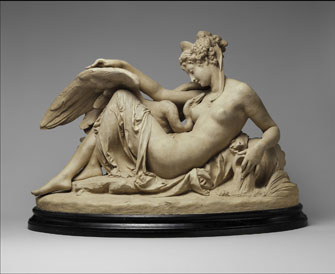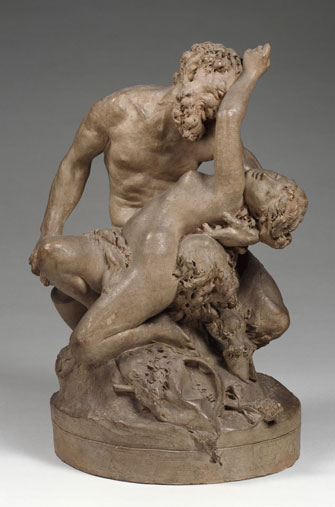A Forgotten
Victorian-era Artist

“Leda et le Cygne” (c. 1870). © The Metropolitan Museum of Art, dist. RMN-Grand Palais/Image of the MMA
Rescued from the oblivion of “unfashionable-
ness” by the head of collections at the Palace of Compiègne, sculptures by Albert-Ernest Carrier-Belleuse (1824-87), currently on show in the exhibition “Carrier Belleuse: Rodin’s Master,” remind us of art preferences during France’s equivalent of the high-Victorian era, the Second Empire. During the 20 years when France was ruled by Napoleon III (a nephew of the original Bonaparte) members of the wealthy bourgeoisie vied with each other to buy works from the prolific Carrier-Belleuse workshop, where the young Rodin was honing his skills.
After training in Paris, the youthful, highly talented Carrier-Belleuse went to work in England in 1850, where the Minton porcelain works appointed him creative director.
Tiring of the Staffordshire potteries, he returned to Paris, keen to make his mark. The skill and panache of the sculptor’s hand is revealed in busts he made during this period, among them a bronze of the painter Delacroix, with the artist wrapped raffishly in a scarf. As Carrier-Belleuse’s work became popular with the haute société around the imperial court – a nouveau-riche milieu of courtesans, rich merchants and moneyed favorites of Napoleon III – his career began to take off. In 1863, the Comtesse de Castiglione paid the artist to produce a statue of her dressed as she appeared at the Imperial Ball on February 9, 1863 – the night she impressed the emperor with her abundant tumbling hair and became his mistress.
The result was a sensation at the Salon of 1866. The next year, the artist won the gold medal at the great Universal Exhibition in Paris, where the wealthy were avid to acquire luxury art objects. Carrier-Belleuse was in the right place, displaying works that showed dazzling technique allied to erotic symbolism. A perfect example is an open-lipped Bacchanthe who submits orgasmically to a leering satyr, her

“Satyre et Nymphe” (c. 1868). © RMN-Grand Palais (Musée d’Orsay)/Hervé Lewandowski
nakedness accentuated by a thin belt holding up a corner of a trailing sheet, which entirely fails to hide her luscious curves.
“Amour et Psyche” (1860) shows a hunky naked angel sleeping while a shapely nude Bacchanthe holding a lamp drools over his body. A hint of erection makes a bulge in the sheet draped over the angel’s hips. Apparently, exhibition-goers in Victorian-era Paris could not get enough of this stuff.
Carrier-Belleuse’s workshop became a highly organized production machine producing artworks of all sizes and diverse materials to meet demand from the petite bourgeoisie. Customers could order reduced-size copies of the famous statues made of cheaper materials than the original. A whole new system of section molds was invented to provide for this market.
Another imperial mistress, the Marquise de Païva, described as the “mondaine par excellence,” commissioned the artist to decorate her palace on the Champs Elysées. It was amid this atmosphere that the young Auguste Rodin, an apprentice in the workshop, learned his craft. When Paris was devastated by the Franco-Prussian War and Commune in 1871, Rodin followed his master to Belgium, where they had been commissioned to make reliefs for the Brussels stock exchange.
Later, Carrier-Belleuse was appointed head of the prestigious Sèvres ceramic works, where he introduced innovative methods and materials for porcelain production. Throughout these years, the ever-more-successful artist was called on to make statues, reliefs and decorations on public buildings, not just for the French capital but for cities all over the world.
In this context, one might mention the words “kitsch” and “commercial”, but there is no taking away the fabulous skill and verve displayed by this talented artist throughout his lifetime.
Palais de Compiègne: Place du Général de Gaulle, 60200 Compiègne. Tel.: 03 44 38 47 00. Open Wednesday-Monday, 10am-6pm. Closed Tuesday. Admission: €9.5. Trains leave the Gare du Nord for Compiègne every 40 minutes. The Palais de Compiègne is an easy walk from the train station. Through October 27. www.musee-chateau-compiegne.fr
Click here to read all of this week’s new articles on the Paris Update home page.
Reader Reaction: Click here to respond to this article (your response may be published on this page and is subject to editing).
Support Paris Update by ordering books from Paris Update’s Amazon store at no extra cost. Click on your preferred Amazon location: U.K., France, U.S.
© 2014 Paris Update
Favorite